Is a Humidifier Good for Indoor Plants? If you’ve ever wondered why some indoor plants thrive while others struggle, the secret might be something simple—humidity.
Plants need the right environment to grow, just like we do. The dry air in our homes, especially during winter, can take away the moisture that plants desperately need. This is where a humidifier can help.
Adding a humidifier to your space might be the missing step in your plant care routine. It helps create the perfect environment for your plants to flourish. Let’s explore how it can make all the difference!
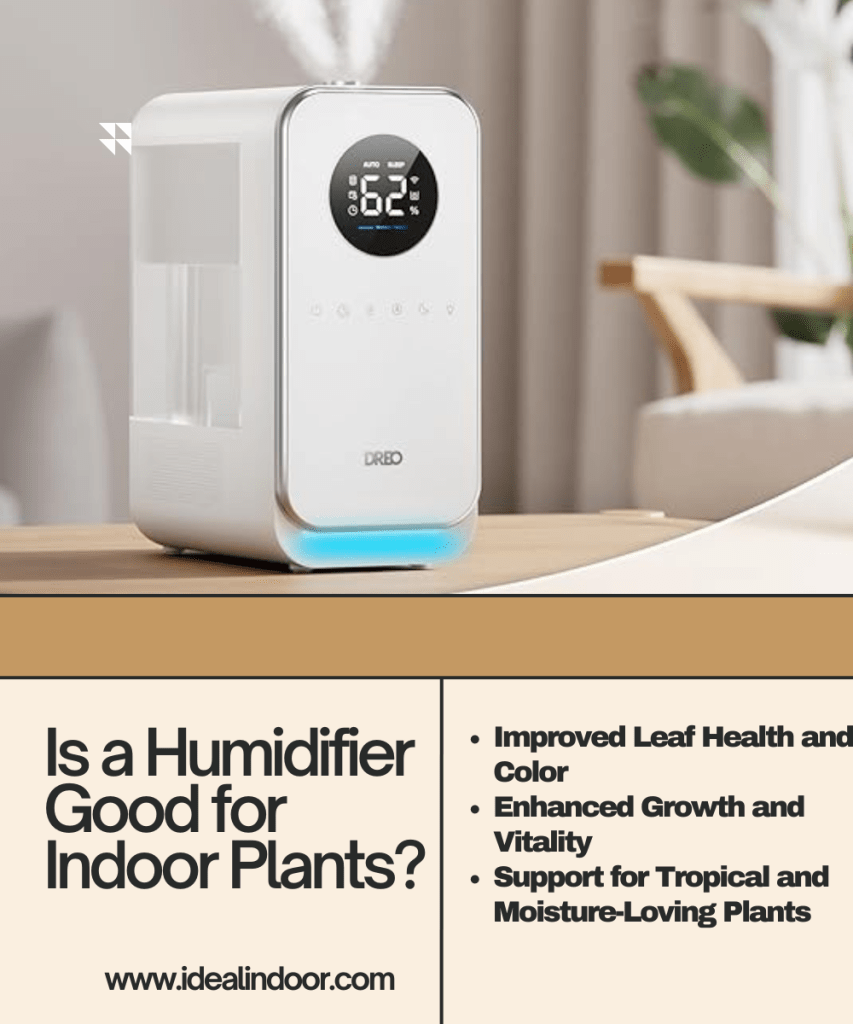
Is a Humidifier Good for Indoor Plants?
Different plants have varying humidity needs, and understanding these can make a significant difference in their growth and vitality. For instance, tropical plants like the popular fiddle leaf fig or the vibrant bird of paradise thrive in high humidity environments. On the other hand, succulents and cacti, which are native to arid regions, prefer lower humidity levels.
It’s essential to recognize the signs of low humidity in your plants. Symptoms such as brown leaf tips, wilting, or leaves that curl inward could be indicators that your plants are not getting enough moisture from the air. Understanding these needs is the first step towards providing the optimal environment for your green friends.
How a Humidifier Benefits Indoor Plants
As renowned horticulturist Lisa Eldridge states, “Consistent humidity is like a breath of fresh air for your indoor plants—it allows them to thrive rather than just survive.”
Using a humidifier can be a game-changer for your indoor plants, especially during dry seasons. A humidifier adds moisture to the air, which can have several direct benefits for your plants:
Improved Leaf Health and Color: When the air around your plants has the right amount of moisture, you’ll notice their leaves stay lush, vibrant, and free of those pesky brown edges.
Enhanced Growth and Vitality: Consistent humidity can lead to better overall growth, as plants are able to absorb water more effectively through their leaves.
Prevention of Leaf Browning and Drying Out: Humidifiers help prevent the stress that leads to browning or drying out of leaves, particularly in tropical plants.
Support for Tropical and Moisture-Loving Plants: Plants that naturally grow in rainforests or other humid climates will feel right at home with the added moisture a humidifier provides.
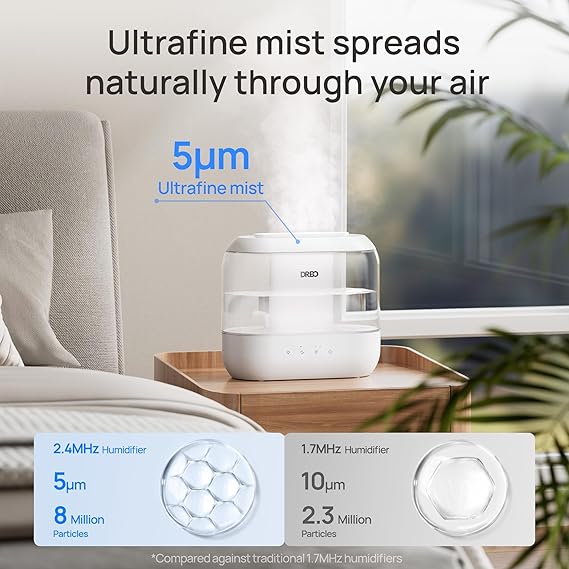
How to Choose the Right Humidifier for My Plants
After noticing that my fiddle leaf fig was struggling with dry, brittle leaves, I realized it was time to invest in a humidifier. I had always heard that humidifiers could help indoor plants thrive, but I wanted to find out for myself—is a humidifier really good for indoor plants?
After researching various models, I settled on the LEVOIT Classic 300 Ultrasonic Top Fill Humidifier, Extra Large 6L Tank. Its 6L capacity meant fewer refills, and the super quiet operation made it perfect for my living space. What truly stood out, however, was how the adjustable mist output and 360° rotation nozzle allowed me to control the humidity level, ensuring it matched the needs of my plants.
Within just a few weeks, I noticed a significant difference. My fiddle leaf fig, which had dry, brittle leaves, started to recover, and other nearby plants also perked up. This experience confirmed that a humidifier is not just good but essential for indoor plants, especially those that thrive in more humid environments. The extra moisture from the Levoit Classic 300 helped recreate the humid conditions many houseplants need, supporting healthier growth and vibrant leaves.
So, is a humidifier good for indoor plants? My experience with the Levoit humidifier says absolutely!
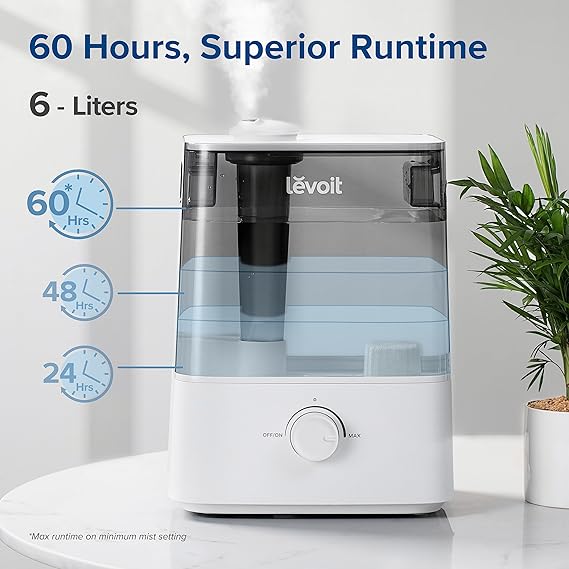
My Plants’ Transformation with a Humidifier
After a few weeks of using my new humidifier, the difference in my plants was undeniable. My fiddle leaf fig, which once had sad, drooping leaves, began to perk up and regain its vibrant green color. The new growth was healthier and more robust than before. Even my peace lilies, which had been struggling with brown tips, started to show signs of recovery.
It wasn’t just the plants nearest the humidifier that benefitted—my entire indoor garden seemed to be more vibrant and lively. The humidifier truly made a noticeable difference in the health and appearance of my plants.
How Often Should You Use a Humidifier for Your Plants?
One of the most common questions plant enthusiasts ask is how often to run their humidifier to ensure optimal plant health. The answer depends on several factors, including the type of plants you have, the size of your room, and the existing humidity levels.
For tropical plants, running the humidifier daily is often recommended, especially during the winter months when indoor heating can significantly dry out the air. In contrast, for succulents or plants that prefer drier conditions, you might only need to run the humidifier a few times a week.
Using a hygrometer—a device that measures humidity—can help you monitor the levels in your home. Aim for a humidity level between 40% and 60% for most indoor plants. By keeping an eye on the numbers, you can adjust your humidifier usage to suit the needs of your plants.
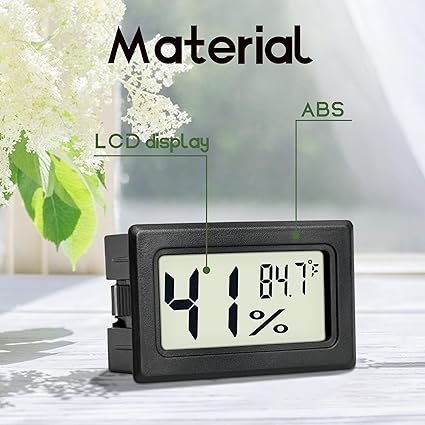
Tips for Success
Getting the most out of your humidifier involves more than just turning it on—proper setup and maintenance are key. Here are some tips to ensure your plants receive the full benefits:
Placement: Position the humidifier near your plants but not too close, as direct mist can lead to excessive moisture on the leaves, potentially causing mold or mildew.
Settings: Adjust the mist output according to the needs of your plants. Some plants may prefer a gentle mist, while others, like ferns, thrive with a more substantial output.
Maintenance: Regularly clean the humidifier to prevent the buildup of mold or bacteria, which could harm your plants. Change the water daily to ensure it remains fresh.
By following these tips, you’ll create a healthy, thriving environment for your indoor garden.
Which Humidifier Is Best for Your Plants?
Not all humidifiers are good for indoor plants—choosing the right type can make a significant difference in your plants’ health.
As Dr. Sarah Coleman, a botanist, explains, “The choice of humidifier depends on the specific needs of your plants and the environment in which they’re kept. Ultrasonic models are often the go-to for their efficiency and quiet operation, making them ideal for home use.”
Here’s a comparison of the most common types:
Ultrasonic Humidifiers: These use ultrasonic vibrations to create a fine mist. They’re generally quiet and energy-efficient. Example: Levoit Classic 300 Ultrasonic Cool Mist Humidifier.
Evaporative Humidifiers: These use a fan to blow air through a wet wick or filter, releasing moisture into the air. They tend to be more affordable but may require more frequent maintenance. Example: Vornado Evap40 4-Gallon Evaporative Humidifier.
Steam Vaporizers: These boil water to create steam, which is then cooled slightly before being released into the air. They’re effective but can be more expensive to run due to higher energy consumption.
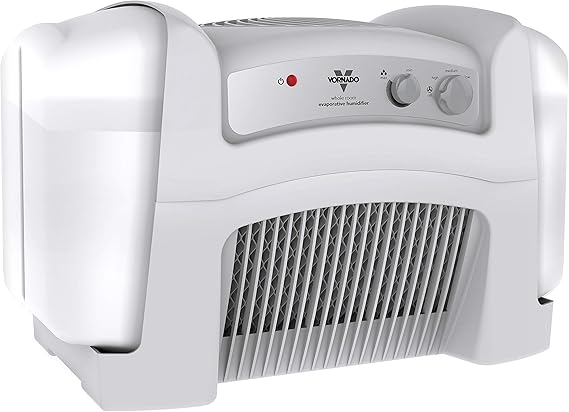
Common Mistakes to Avoid When Using a Humidifier for Plants
While using a humidifier can greatly benefit your plants, it’s important to avoid common pitfalls that can do more harm than good:
Over-Humidification: Too much humidity can lead to mold growth on the soil or plant leaves, which can harm your plants. Be sure to monitor the humidity levels and adjust the mist output accordingly.
Inconsistent Usage: Plants need consistent humidity to thrive. Sporadic use of a humidifier can cause stress to your plants, leading to poor health.
Poor Placement: Placing the humidifier too close to your plants can cause water to collect on the leaves, leading to potential fungal infections. Keep it at a safe distance where the mist can disperse evenly.
By being mindful of these potential issues, you can ensure that your humidifier is helping, not harming, your indoor plants.
How to Increase Humidity Without a Humidifier
If you’re not ready to invest in a humidifier, there are still ways to increase humidity for your plants naturally:
Misting: Regularly misting your plants with water can provide a temporary boost in humidity. However, it’s not as effective as a humidifier and requires frequent attention.
Pebble Trays: Placing plants on trays filled with water and pebbles can create a microclimate of higher humidity around the plants.
Grouping Plants: Grouping plants together can help create a more humid environment as the plants release moisture into the air.
While these methods can help, they may not be as reliable or effective as using a humidifier, especially in dry climates.
Is a Humidifier Worth It for Your Indoor Plants?
After seeing the positive impact a humidifier has had on my plants, I can confidently say it’s a worthy investment for any plant lover. The ability to control and maintain optimal humidity levels can make all the difference in the health and appearance of your indoor garden.
Whether you have a collection of moisture-loving tropical plants or just want to give your houseplants the best chance to thrive, a humidifier can be a game-changing addition to your plant care routine. So, if you’ve been on the fence about whether a humidifier is worth it, take it from me—your plants will thank you!